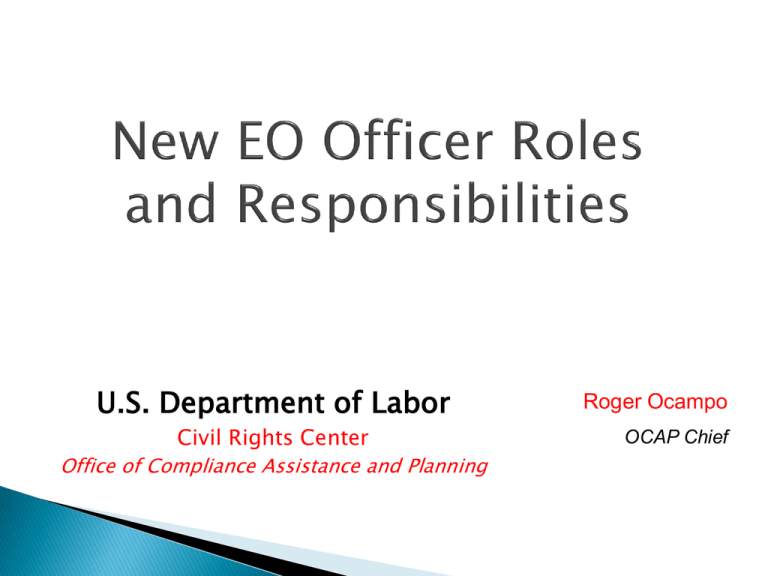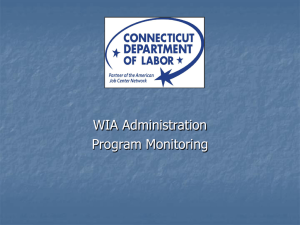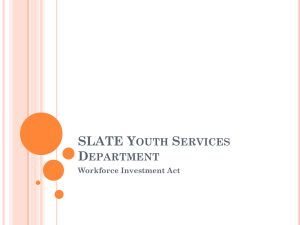
U.S. Department of Labor
Civil Rights Center
Office of Compliance Assistance and Planning
Roger Ocampo
OCAP Chief
Introduction to CRC
Who must designate an EO Officer
Who is eligible to be an EO Officer
What are the EO Officer responsibilities
The MOA and the EO Officer
Recipient’s obligations to the EO Officer
Upcoming training
Questions and Answers
CRC enforces various Federal civil rights laws, including
laws that cover programs and activities that either are
conducted by DOL itself, or receive certain types of financial
assistance from the Federal government.
Section 188 of WIA is a primary source of CRC’s authority.
Section 188 prohibits discrimination, and requires equal
opportunity, in the workforce development system on the
bases of race, color, national origin, religion, age, sex,
disability, citizenship, political affiliation or belief, and status
as a participant in a WIA Title I-financially assisted program
or activity. The nondiscrimination regulations that implement
WIA Section 188, which are enforced by CRC, are published
at 29 CFR part 37.
All programs and activities offered through the One-Stop system by
“One-Stop partners” are covered by the WIA nondiscrimination
regulations, even if the principal source of financial assistance for a
program or activity is a Federal department or agency other than DOL.
Examples include:
• DOL programs: Unemployment Insurance (UI); Wagner-Peyser /
employment service (ES) programs; Job Corps; programs for Native
Americans and migrant and seasonal farmworkers; veterans' workforce
investment programs; the Senior Community Service Employment
Program (SCSEP); the Trade Adjustment Assistance program (TAA);
YouthBuild
• Department of Education-funded programs: adult education and
literacy activities under WIA Title II; vocational rehabilitation programs;
vocational education programs
• Department of Health and Human Service-funded programs:
Temporary Assistance for Needy Families (TANF); employment and
training activities carried out under Community Services Block Grants
• Department of Housing and Urban Development-funded programs:
all employment and training programs carried out by HUD
• Department of Agriculture: the Food Stamp program
• Programs and activities funded by other Federal departments and
agencies: Examples include AmeriCorps, USA Freedom Corps,
Volunteers for America, and other programs authorized by the National
and Community Service Act of 1990
• “Other appropriate Federal, State, or local programs, including
programs in the private sector”: under this provision, CRC has
jurisdiction over any employment-related programs instituted under the
American Recovery and Reinvestment Act (ARRA) that are offered by
One-Stop partners through the One-Stop system.
29 CFR § 37.23 Who must designate an Equal Opportunity Officer?
Every recipient must designate an Equal Opportunity
Officer (“EO Officer”), except small recipients and service
providers, as defined in §37.4*. The responsibilities of
small recipients and service providers are described in
§§37.27 and 37.28.
*Small recipient means a recipient who (a) serves a total of fewer than 15
beneficiaries during the entire grant year, and (b) Employs fewer than 15
employees on any given day during the grant year.
29 CFR § 37.24 Who is eligible to serve as an Equal Opportunity Officer?
A senior-level employee of the recipient should be
appointed as the recipient's Equal Opportunity Officer.
Depending upon the size of the recipient, the size of the
recipient's WIA Title I-financially assisted programs or
activities, and the number of applicants, registrants, and
participants served by the recipient, the EO Officer may,
or may not, be assigned other duties. However, he or she
must not have other responsibilities or activities that
create a conflict, or the appearance of a conflict, with the
responsibilities of an EO Officer.
29 CFR § 37.25 What are the responsibilities of an Equal Opportunity Officer?
An Equal Opportunity Officer is responsible for coordinating a
recipient's obligations under this part. Those responsibilities
include, but are not limited to:
(a) Serving as the recipient's liaison with CRC;
(b) Monitoring and investigating the recipient's activities, and
the activities of the entities that receive WIA Title I funds from
the recipient, to make sure that the recipient and its
subrecipients are not violating their nondiscrimination and
equal opportunity obligations under WIA Title I and this part;
(c) Reviewing the recipient's written policies to make sure that
those policies are nondiscriminatory;
(d) Developing and publishing the recipient's procedures for
processing discrimination complaints under §§37.76 through
37.79, and making sure that those procedures are followed;
(e) Reporting directly to the appropriate official (including, but
not limited to, the State WIA Director, Governor's WIA
Liaison, Job Corps Center Director, SESA Administrator, or
LWIA grant recipient) about equal opportunity matters;
(f) Undergoing training (at the recipient's expense) to
maintain competency, if the Director requires him or her,
and/or his or her staff, to do so; and
(g) If applicable, overseeing the development and
implementation of the recipient's Methods of Administration
under §37.54.
Each Governor must establish and adhere to a
Methods of Administration for State programs as
defined in §37.4.
Each Methods of Administration must be designed
to give a reasonable guarantee that all recipients
will comply, and are complying, with the
nondiscrimination and equal opportunity provisions
of WIA and this part.
From 29 CFR 37.54
Role of the MOA
“…the MOA is intended to be a
document that State-and local-level
staff and management, through the
EO Officer, can consult when
determining appropriate steps to take
when confronted with an EO issue.”
--State Guidance for Developing Methods of Administration (MOA) Required by
Regulations Implementing Section 188 of the Workforce Investment Act of 1998 (WIA)
Federal Register / Vol. 65, No. 166 / Friday, August 25, 2000 / Notices/Page 51984
MOA Elements
1. Designation of Equal Opportunity Officers
2. Notice & Communication
3. Assurances, Contracts & Other Agreements
4. Universal Access
5. Compliance with Federal disability
nondiscrimination laws
6. Data Collection & Record keeping
7. Monitoring
8. Complaint Processing Procedures
9. Corrective Actions/Sanctions Procedures
Element 1. Designation of State-and
local-level Equal Opportunity (EO)
Officers
“…any individual appointed as EO Officer
should have the skill, ability, knowledge and
authority to properly oversee and direct the EO
program to which that individual has been
assigned.”
Element 2. Notice and Communication
“…ensure the establishment of a notice and
communication system that makes all registrants,
applicants, eligible applicants/registrants,
applicants for employment, employees and
interested members of the public aware of both the
recipient's obligation to operate its programs and
activities in a nondiscriminatory manner, and the
extent of the rights of members of these groups to
file complaints of discrimination.”
Element 3. Review assurances, job training
plans, contracts, and policies and
procedures
“…the procedures the State and its recipients are
following and will continue to follow in assessing
the ability of grant applicants, if funded, or
training providers, if declared eligible, to comply
with WIA section 188 and 29 CFR part 37.”
Element 4. Universal Access
“…comply with the requirements of 29 CFR
37.42 relating to the provision of universal
access to programs and activities.”
“make efforts… to broaden the composition of
the pool of those considered for participation or
employment in their programs and activities in
an effort to include members of both sexes, of
the various racial and ethnic groups and of
various age groups, as well as individuals with
disabilities.”
Element 5. Compliance with Federal disability
nondiscrimination laws
“…comply with the requirements of the disability
related requirements of WIA section 188; Section 504
of the Rehabilitation Act of 1973, as amended; and
their implementing Regulations…”
•reasonable accommodations
•reasonable modification of policies, practices and procedures
•architectural accessibility
•programmatic accessibility
•communicate with persons with disabilities as effectively as
with others
•confidentiality of medical information
Element 6. Data and Information Collection
and Maintenance
…ensure that a data and information collection and
maintenance system for its WIA Title I-financially
assisted State programs is established and
maintained. (See 29 CFR 37.53.)”
•Monitoring recipient equal opportunity performance;
•Identifying instances or areas of discrimination; and
•Identifying individuals or groups of individuals who
have been discriminated against on a basis
prohibited by WIA section 188 and 29 CFR part 37.
Element 7. Monitor Recipients for Compliance
“…establish procedures to monitor periodically all
aspects of the recipient's compliance with WIA
section 188 and 29 CFR part 37.”
Each EO monitoring review must include a review of each
recipient’s:
• Compliance with its administrative obligations under WIA
section 188 and 29 CFR part 37 (e.g., assurances, notice
and communication, EO Officers);
• Compliance with responsibilities it has been assigned
through the MOA;
• Programs and activities, to determine whether
discrimination is occurring. This activity is the most important
part of the monitoring review.
Element 8. Complaint Processing
Procedures
“…comply with the requirements of 29 CFR
37.76 through 37.79 regarding complaint
processing procedures.”
…and those procedures are….
a) Written Notice of Final Action issued within 90 days.
b) Procedures must include:
(1) Initial written notice acknowledging the complaint and giving right to
be represented in the complaint process;
(2) A written statement listing the issues raised and whether the
recipient will accept or reject each issue for investigation (giving
reasons for when an issue is rejected)
(3) A period for fact-finding or investigation;
(4) A period to attempt resolution of the complaint.
(5) A written Notice of Final Action that contains:
(i) For each issue, either: (A) The recipient's decision and
explanation of the reasons for the decision, or (B) A description
of the way the parties resolved the issue; and
(ii) Notice of a right to file a complaint with CRC within 30 days.
c) The procedures must provide for alternative dispute resolution (ADR).
Element 9. Corrective Actions/Sanctions
“…comply with the requirements of 29 CFR
37.54(d)(2)(vii).” 29 CFR 37.54(d)(2)(vii):
Procedures for obtaining prompt corrective
action or, as necessary, applying sanctions
when noncompliance is found…”
29 CFR § 37.110 What enforcement procedures does the
Department follow to effect compliance with the
nondiscrimination and equal opportunity provisions of WIA
and this part?
(a) … the Secretary may:
(1) After opportunity for a hearing, suspend, terminate,
deny or discontinue the WIA Title I financial assistance, in
whole or in part;
(2) Refer the matter to the Attorney General with a
recommendation that an appropriate civil action be
instituted; or
(3) Take such action as may be provided by law.
(b) Deferral of new grants. When proceedings under §37.111
have been initiated against a particular recipient, the
Department may defer action on that recipient's applications
for new WIA Title I financial assistance until a Final Decision
under §37.112 has been rendered.
29 CFR § 37.26 What are a recipient's obligations relating to the Equal Opportunity
Officer?
A recipient has the following obligations:
(a) Making the Equal Opportunity Officer's name, and his or her
position title, address, and telephone number (voice and
TDD/TTY) public;
(b) Ensuring that the EO Officer's identity and contact
information appears on all internal and external communications
about the recipient's nondiscrimination and equal opportunity
programs;
(c) Assigning sufficient staff and resources to the
Equal Opportunity Officer, and providing him or her
with the necessary support of top management, to
ensure compliance with the nondiscrimination and
equal opportunity provisions of WIA and this part;
and
(d) Ensuring that the EO Officer and his/her staff
are afforded the opportunity to receive the training
necessary and appropriate to maintain
competency.
Save the Date
August 9 — August 13, 2010
Marriott Bethesda North Hotel and Conference Center
Bethesda, MD
More Info Coming Soon
May 19, 2010
An Overview of the Methods of Administration
June 16, 2010
Introduction to WIA Related Disability
Requirements and Resources
July 14, 2010
LEP Requirements and Resources
September 1, 2010
Compliant Discrimination Complaint Processing
September 29, 2010
Introduction to Discrimination Statistical Analyses
Webinar announcements and registration information
will be posted on CRC’s website
CRC
Other Labor
Other Federal
◦ Website
Statues and Regulations
MOA Checklist
Online Training
◦ ODEP
◦ ETA
◦ BLS
◦ DOJ
◦ EEOC








